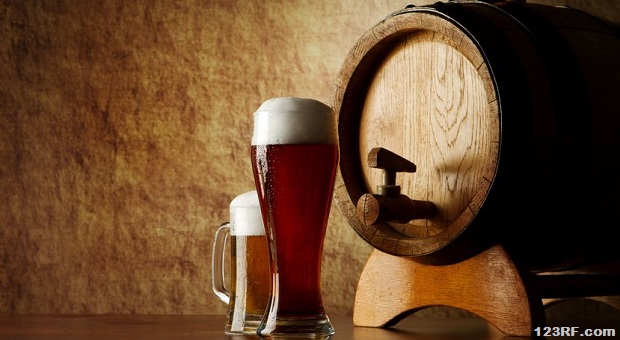Have you ever been sipping a cold one and wondered to yourself, “Self, what would happen if there suddenly was no more beer manufacturers? Can I make this myself?” As a prepper and a do-it-yourselfer, you most likely have, and the answer is yes, but we’re going to have to qualify it. Yes, you can make your own beer at home as long as you’ve stockpiled the equipment and the ingredients.
Making beer isn’t like making wine; you can’t just toss some grape juice, yeast and sugar in a bottle and wait it out. You really do need 3 specialized ingredients (hops, beer yeast, and fermented sugar) a couple of common ingredients and some fairly specialized yet simple equipment.
{adinserter emp}You can also opt to start with a beer kit, which will provide you with everything that you need to get started, but will only have enough supplies for your first batch or two. After that, you’ll need to order ingredients but you’ll have your equipment.
Since bottles may be rare in a post-SHTF world, we’re going to tell you how to store your beer in casks instead of bottling it after we go through the process of making it, too. You know, just in case you want to open the first saloon when society starts to restructure, or if you just want really good beer.
For simplicity, because you probably won’t be growing your own wheat and making your own malt, we’re going to use an extract. You can, of course, make it straight from wheat but that would require, well, wheat.
Equipment:
- 2 food-grade 5-gallon buckets with lids, or 1 bucket and 1 “carboy”, a 5-gallon glass bottle
- Large pot or kettle that will hold at least 3 gallons of liquid with extra room to spare
- 6 feet of plastic, food-grade tubing
- 1 airlock, aka fermentation lock, to keep bacteria out of your beer while letting Co2 out.
- 1 long spoon – you’ll use this for stirring so make sure it’s long enough to stir your pot.
- At least 55 bottles
- At least 55 bottle caps (not twist-offs)
- 2 bottle cappers
- Bottling wand
- 1 large funnel
- Food thermometer
- A cool place to ferment – cooler, fridge, cold basement, cellar
Ingredients:
These are the ingredients you’ll need to make basic ale. 5 gallons of filtered, purified water
- 6 pounds of DME (dry malt extract)
- 1 oz. hop pellets, your choice (this will play a huge part in the taste of the beer)
- 14g (2 7oz packs) ale yeast
- 1 C warm water to activate the yeast in
- 3/4 C liquid corn syrup
Before you start the process of actually making beer at home, you need to carefully sanitize all of your equipment. Any bacteria will cause spoilage of your beer, or at the very least will affect the flavor.
As a good prepper, you should have plenty of bleach stored back so make yourself a bleach solution with 1T of bleach per gallon of water to sanitize stuff so that you kill all the nasties.
Video first seen on Jonny Keeley.
Brew It Up
Now to the good part – making your beer at home!
- Gather all of your ingredients and equipment.
- Place your hops pellets in cheesecloth or some type of clean cloth so that it just steeps in the beer.
- Pour 1.5 gallons of water into your kettle and bring it to a boil.
- Remove from heat and add the malt, stirring so that it’s all dissolved. If it sinks to the bottom, it’ll burn, and burned malt tastes like crap.
- Bring it back to a boil for about 50 minutes. It’s going to bubble so be sure to watch it carefully. If you need to beat back the foam to keep it from overflowing, spray it with a bit of water in a spray bottle.
- Add your hops. Now the mix will get REALLY foamy so watch it carefully and spray if necessary; you can’t walk away at this point.
- Boil for another 10-20 minutes, depending upon how “hoppy” you want your beer.
- While your wort (that’s what the mix is called) is boiling, dissolve your yeast in the water. If it doesn’t activate (get bubbly), your yeast is no good. Try again with fresh yeast or your beer won’t ferment correctly.
- Next, you can either remove from heat and let it cool naturally or place the pot in an ice bath to cool it quickly. If you use an ice bath, it will take about 20 minutes to cool. Stir it a bit so that it cools faster.
Fermenting
- Pour the remaining 3.5 gallons of water into your fermenting bucket or carboy and use the funnel to add the wort.
- Sprinkle in the yeast and then stir it or add the lid and shake it so that the yeast dissolves.
- Add the airlock and store in a cool place (60-75 degrees F) such as a dark room or your basement or cellar, where no light will get to it. Some foam will likely escape through the airlock so make sure that it’s not going to ruin anything that the carboy or bucket is sitting on.
- The fermentation process should take about 2 weeks. If the temperature of the room raises and the airlock stops bubbling, you need to move it to a cooler place right then.
- If all is well, the airlock will have a slow trickle of bubbles that will increase for a few days, then decrease over the next few days.
- It’s possible that the fermentation process will pop your airlock out. If that happens, just sanitize it and put it back in.
Bottling or Casking
Now it’s time to store your beer. Regardless of whether you’re using bottles or a cask/keg, sanitize them well and let them air dry. Your bottles caps will come with sanitizing instructions.
- In a sanitized pot, bring the corn syrup and 1 cup of water to a boil and boil it for 10 minutes. Don’t use too much syrup because the beer will over-carbonate and cause the bottles to explode.
- Cool for 10 minutes and pour the sugar mixture into your bottling bucket. (or your cask if you’re casking)
- Set your full fermentation bucket on the counter and place the bottling bucket in the floor beneath it.
- Using your sanitized siphoning hose, begin to siphon the beer from the fermentation bucket into the bottling bucket (or cask). Control how fast it flows by pinching the siphon. You don’t want it to splash but rather to flow gently in.
- After all the beer has siphoned into the bottling bucket, cover and allow it to set for 30 minutes so that the sediment sinks.
- Now move the bottling bucket gently to the counter and siphon the beer into your bottles, leaving 3/4-inch headspace.
- Cap each bottle securely.
- Let the bottles age for at least 2 weeks, but up to 2 months, then enjoy!
- If you’ve placed your beer in a cask, store it somewhere cool, 55-65 degrees, with the airlock still in place.
- Sample after a few days and drink it when it’s ready, or bottle it if you were casking for flavor. If you do use a cask, make sure that your siphon hose is a couple of inches or so off the bottom so that you’re not siphoning the dead yeast and sediment off the bottom.
Casked beers go bad more quickly than bottled beers, so keep that in mind. There’s a whole art to choosing your casks, too, but that’s an article for another day!
After you get the hang of this basic recipe for making beer at home, you can experiment with different hops and yeasts to alter the flavors. You can even add fruits or spices to make your very own craft beers. Once you get the basics and understand the science, the world is your brew-toy. Enjoy!
This article has been written by Theresa Crouse for Survivopedia.









Pingback:How to Make Beer at Home from Scratch | Survivalist Basics | Be Prepared For Anything! | September 28, 2014
|
Pingback:Home brewed Beer. Yes you can do it!Preppers | September 28, 2014
|
Pingback:Back to Basics: How To Make Wine At Home disasterdefense.usdisasterdefense.us | disasterdefense.us | June 18, 2015
|
Pingback:Back To Basics: How To Make Rum At Homedisasterdefense.us | disasterdefense.us | September 16, 2015
|
Pingback:Back to Basics: How To Make Wine At Home | November 1, 2015
|
Pingback:How To Brew Delicious and Cheap Beer At Home in 9 Easy Steps | News | December 21, 2015
|
Pingback:Back To Basics: How To Make Rum At Home – The Prepper Dome | December 30, 2015
|
Pingback:» Back To Basics: How To Make Rum At Home - Prepper Ways | May 11, 2016
|
Pingback:Surviving The Next Great Depression | Survivopedia | October 31, 2017
|
Niels Glx | May 16, 2018
|
Thanks for sharing this nice and helpful tips.
Pingback:Back to Basics: How To Make Wine At Home | Survivopedia | July 25, 2018
|